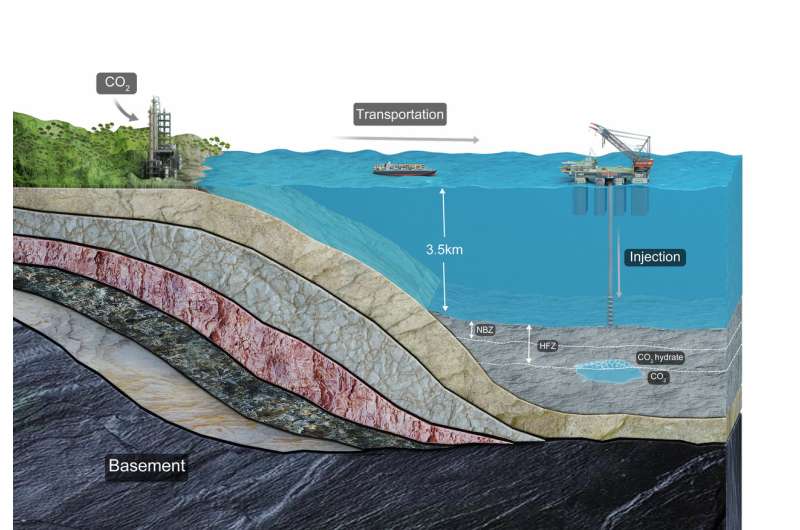July 5, 2018 report
Model suggests sequestering CO2 in deep sea sediments might be viable option

A pair of researchers at Peking University has found evidence that suggests liquid CO2 could be safely sequestered in deep sea sediments. In their paper posted on the open access site Science Advances, Yihua Teng and Dongxiao Zhang describe a model they built to mimic CO2 injections beneath the ocean floor and what it showed.
As the planet continues to heat up due to the continued release of greenhouse gases into the atmosphere, scientists look for other places to store them. Carbon dioxide has been singled out as one of the major greenhouse gases and because of that, efforts have been made to curb its release. Some approaches have focused on looking for ways to prevent is release, while others look for ways to capture and store it where it will not eventually leak into the atmosphere. One such place is in sediments that lie at the bottom of the ocean. But, as the authors note, little work has been done to find out if such a site might be able to hold CO2 without leakage into the water—and eventually into the atmosphere. In this new effort, the researchers built a model meant to mimic ocean floor sediment conditions and what might happen if liquid CO2 were injected into it.
One of the major culprits involved in releasing CO2 into the atmosphere is coal-burning power plants. Work is currently being done to find ways to sequester the CO2 in these emissions. Such work has shown that CO2 can be captured and converted to various forms, from solids to liquids. It is the liquid form that the researchers with this new effort address.
Prior research has shown that when liquid CO2 is exposed to both high pressure and low temperatures, hydrates form. The researchers added this information to their model and then ran it multiple times under different conditions such as varying pressure and time scales. They found that under certain conditions, injecting CO2 into the sediments led to the formation of hydrates, which then served as a form of cap, preventing the CO2 liquid from seeping upward. They further found that over time, both the CO2 and the hydrates dissolved into pore fluids.
Emboldened by their results, the researchers suggest real-world studies of CO2 sequestration in seafloor sediments to determine if it is a viable solution.
More information: Yihua Teng et al. Long-term viability of carbon sequestration in deep-sea sediments, Science Advances (2018). DOI: 10.1126/sciadv.aao6588
Abstract
Sequestration of carbon dioxide in deep-sea sediments has been proposed for the long-term storage of anthropogenic CO2 that can take advantage of the current offshore infrastructure. It benefits from the negative buoyancy effect and hydrate formation under conditions of high pressure and low temperature. However, the multiphysics process of injection and postinjection fate of CO2 and the feasibility of subseabed disposal of CO2 under different geological and operational conditions have not been well studied. With a detailed study of the coupled processes, we investigate whether storing CO2 into deep-sea sediments is viable, efficient, and secure over the long term. We also study the evolution of multiphase and multicomponent flow and the impact of hydrate formation on storage efficiency. The results show that low buoyancy and high viscosity slow down the ascending plume and the forming of the hydrate cap effectively reduces permeability and finally becomes an impermeable seal, thus limiting the movement of CO2 toward the seafloor. We identify different flow patterns at varied time scales by analyzing the mass distribution of CO2 in different phases over time. We observe the formation of a fluid inclusion, which mainly consists of liquid CO2 and is encapsulated by an impermeable hydrate film in the diffusion-dominated stage. The trapped liquid CO2 and CO2 hydrate finally dissolve into the pore water through diffusion of the CO2 component, resulting in permanent storage. We perform sensitivity analyses on storage efficiency under variable geological and operational conditions. We find that under a deep-sea setting, CO2 sequestration in intact marine sediments is generally safe and permanent.
Journal information: Science Advances
© 2018 Phys.org




















